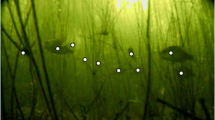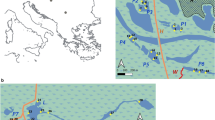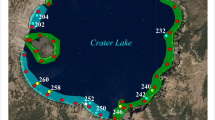Abstract
A presumed value of shallow-habitat enhanced pelagic productivity derives from the principle that in nutrient-rich aquatic systems phytoplankton growth rate is controlled by light availability, which varies inversely with habitat depth. We measured a set of biological indicators across the gradient of habitat depth within the Sacramento–San Joaquin River Delta (California) to test the hypothesis that plankton biomass, production, and pelagic energy flow also vary systematically with habitat depth. Results showed that phytoplankton biomass and production were only weakly related to phytoplankton growth rates whereas other processes (transport, consumption) were important controls. Distribution of the invasive clam Corbicula fluminea was patchy, and heavily colonized habitats all supported low phytoplankton biomass and production and functioned as food sinks. Surplus primary production in shallow, uncolonized habitats provided potential subsidies to neighboring recipient habitats. Zooplankton in deeper habitats, where grazing exceeded phytoplankton production, were likely supported by significant fluxes of phytoplankton biomass from connected donor habitats. Our results provide three important lessons for ecosystem science: (a) in the absence of process measurements, derived indices provide valuable information to improve our mechanistic understanding of ecosystem function and to benefit adaptive management strategies; (b) the benefits of some ecosystem functions are displaced by water movements, so the value of individual habitat types can only be revealed through a regional perspective that includes connectedness among habitats; and (c) invasive species can act as overriding controls of habitat function, adding to the uncertainty of management outcomes.








Similar content being viewed by others
References
Alpine AE, Cloern JE. 1992. Trophic interactions and direct physical effects control phytoplankton biomass and production in an estuary. Limnol Oceanogr 37:946–955
Andersen T, Hessen DO. 1991. Carbon, nitrogen, and phosphorus content of freshwater zooplankton. Limnol Oceanogra 36:807–814
Atwater BF, Conard SG, Dowden JN, Hedel CW, MacDonald RL, Savage W. 1979. History, landforms, and vegetation of the estuary’s tidal marshes. In: Conomos TJ (eds). San Francisco Bay: The Urbanized Estuary. San Francisco (CA): Pacific Division, American Association for the Advancement of Science, pp 347–385
Bennett WA, Moyle PB. 1996. Where have all the fishes gone? Interactive factors producing fish declines in the Sacramento-San Joaquin Estuary. In: Hollibaugh JT (eds). San Francisco Bay: The ecosystem. San Francisco (CA): Pacific Division, American Association for the Advancement of Science, pp 519–542
Bogdan KG, Gilbert JJ. 1982. Seasonal patterns of feeding by natural populations of Keratella, Polyarthra, and Bosmina: clearance rates, selectivities, and contributions to community grazing. Limnol and Oceanogr 27:918–934
Bottrell HH, Duncan A, Gliwicz ZM, Grygierek E, Herzig A, Hillbricht-Ilkowska A, Kurasawa H, and others. 1976. A review of some problems in zooplankton production studies. Nor J Zool 24:419–456
Brett MT, Müller-Navarra DC, Park SK. 2000. Empirical analysis of the effect of phosphorus limitation on algal food quality for freshwater zooplankton. Limnol Oceanogr 45:1564–1575
Brown LR. 2003. Will tidal wetland restoration enhance populations of native fishes? In: Brown LR, Ed. Issues in San Francisco Estuary tidal wetlands restoration. San Francisco Estuary and Watershed Science (online serial). 1(1): Article 2
CALFED Bay-Delta Program. 2000. CALFED Bay-Delta Program strategic plan for ecosystem restoration. Sacramento (CA): CALFED Bay-Delta Program
CALFED Bay-Delta Program. 2001. Ecosystem restoration program draft stage 1 implementation plan. Sacramento (CA): CALFED Bay-Delta Program
California Bay-Delta Authority. 2004. Ecosystem restoration program multi-year program plan. Sacramento (CA): CALFED Bay-Delta Program
Caraco NF, Cole JJ, Raymond PA, Strayer DL, Pace ML, Findlay SE, Fischer DT. 1997. Zebra mussel invasion in a large, turbid river: phytoplankton response to increased grazing. Ecology 78:588–602
Clark TW, Zaunbrecher D. 1987. The greater Yellowstone ecosystem: the ecosystem concept in natural policy and management. Renewable Resour 5(3):8–16
Cloern JE. 1982. Does the benthos control phytoplankton biomass in south San Francisco Bay? Mar Ecol Prog Ser 9:191–202
Cloern JE, Dufford R. 2005. Phytoplankton community ecology: principles applied in San Francisco Bay. Mar Ecol Prog Ser 285:11–28
Cloern JE, Cole BE, Wong RLJ, Alpine AE. 1985. Temporal dynamics of estuarine phytoplankton: a case study of San Francisco Bay. Hydrobiologia 129:153–176
Cloern JE, Grenz C, Lucas LV. 1995. An empirical model of the phytoplankton chlorophyll:Carbon ratio—the conversion factor between productivity and growth rate. Limnol Oceanogr 40:1313–1321
Cohen AN, Carlton JT. 1998. Accelerating invasion rate in a highly invaded estuary. Science 279:555–558
Crisp DJ. 1971. Energy flow measurements. In: Holme NA, McIntyre AD, Ed. Methods of the study of marine benthos. International Biological Programme handbook no. 16. Oxford (UK): Blackwell. p 197–279
Dumont H, Van de Velde I, Dumont S. 1975. The dry weight estimate of biomass in a selection of cladocera, copepoda and rotifera from the plankton, periphyton and benthos of continental waters. Oecologia (Berlin) 19:75–97
Engelhardt KAM, Ritchie ME. 2001. Effects of macrophyte species richness on wetland ecosystem functioning and services. Nature 411:687–9
Feyrer F, Herbold B, Matern SA, Moyle PB. 2003. Dietary shifts in a stressed fish assemblage: consequences of a bivalve invasion in the San Francisco estuary. Environ Biol Fishes 67:277–88
Fischer HB, List EJ, Imberger J, Koh RCY, Brooks NH. 1979. Mixing in inland and coastal waters. New York: Academic Press. 483 p.
Foe C, Knight A. 1986. A thermal energy budget for juvenile Corbicula fluminea. Am Malacol Bull Sp edn. no. 2; p 143–150
Grimaldo LF, Miller RE, Peregrin CM, Hymanson ZP. 2004. Spatial and temporal distribution of native and alien ichthyoplankton in three habitat types of the Sacramento–San Joaquin Delta. In: Feyrer F, Brown LR, Orsi JJ, Eds. Early life history of fishes in the San Francisco Estuary and watershed. American Fisheries Society Symposium 39. p 81–96
Hager SW. 1994. Dissolved nutrient and suspended particulate matter data for the San Francisco Bay Estuary, California. October 1991 through November 1993. US Geological Survey Open-File Report 94-471. p 53
Harris RP, Paffenhöfer GA. 1976. The effect of food concentration on cumulative ingestion and growth efficiency of two small marine planktonic copepods. J Mar Biol Assoc UK 56:875–88
Holl KD, Crone EE, Schultz CB. 2003. Landscape restoration: moving from generalities to methodologies. BioScience 53:491–502
Holling CS. 1978. Adaptive environmental assessment and management. New York: Wiley
Jack JD, Thorp JH. 2000. Effects of the benthic suspension feeder Dreissena polymorpha on zooplankton in a large river. Fresh Biol 44:569–79
Jacobs KL, Luoma SN, Taylor KA. 2003. CALFED: An experiment in science and decision making. Environment 45(1):30–41
Jassby AD, Cloern JE, Cole BE. 2002. Annual primary production: patterns and mechanisms of change in a nutrient-rich tidal ecosystem. Limnol and Oceanogr 47:698–712
Jeppesen E, Jensen JP, Jensen C, Faafeng B, Hessen DO, Søndergaard M, Lauridsen T, and others. 2003. The impact of nutrient state and lake depth on top–down control in the pelagic zone of lakes: a study of 466 lakes from the temperate zone to the arctic. Ecosystems 6:313–25
Kimmerer WJ. 2002. Effects of freshwater flow on abundance of estuarine organisms: physical effects of trophic linkages? Mar Ecol Progr Ser 243:39–55
Kimmerer WJ, Orsi JJ. 1996. Changes in the zooplankton of the San Francisco Bay Estuary since the introduction of the clam Potamocorbula amurensis. In: Hollibaugh JT, editor. San Francisco Bay: the ecosystem. San Francisco (CA): Pacific Division, American Association for the Advancement of Science. p 403–24
Knowles N. 2002. Natural and management influences on freshwater inflows and salinity in the San Francisco Estuary at monthly to interannual scales. Water Resour Res 38:25-1–25-11
Lucas LV, Cloern JE, Thompson JK, Monsen NE. 2002. Functional variability of habitats within the Sacramento–San Joaquin Delta: restoration implications. Ecol Appl 12:1528–1547
Monsen N. 2001. A study of subtidal transport in Suisun Bay and the Sacramento–San Joaquin Delta, California. [Dissertation]. Stanford, (CA): Stanford University. p 344
Monsen NE, Cloern JE, Lucas LV, Monismith SG. 2002. A comment on the use of flushing time, residence time, and age as transport time scales. Limnol Oceanogr 47:1545–1553
Moulton TP. 1999. Biodiversity and ecosystem functioning in conservation of rivers and streams. Aquatic Conservation: Mar Freshw Ecosyst 9:573–578
Müller-Navarra DC, Brett MT, Park SC, Chandra S, Ballantyne AP, Zorita E, Goldman CR. 2004. Unsaturated fatty acid content in seston and tropho-dynamic coupling in lakes. Nature 427:69–71
Müller-Solger AB, Jassby AD, Müller-Navarra DC. 2002. Nutritional quality of food resources for zooplankton (Daphnia) in a tidal freshwater system (Sacramento–San Joaquin River Delta). Limnol Oceanogr 47:774–777
Mullin MM, Brooks ER. 1967. Laboratory culture, growth rate, and feeding behavior of a planktonic marine copepod. Limnol Oceanogr 12:657–666
Nichols FH, Thompson JK, Schemel LE. 1990. Remarkable invasion of San Francisco Bay (California, USA) by the Asian clam Potamocorbula amurensis. II Displacement of a former community. Mar Ecol Progr Ser 66:95–101
Noss RF. 1983. A regional landscape approach to maintain diversity. BioScience 33:700–706
O’Riordan CA, Monismith SG, Koseff JR. 1995. The effect of bivalve excurrent jet dynamics on mass transfer in a benthic boundary layer. Limnol Oceanogr 40:330–344
Orsi JJ, Mecum WL. 1996. Food limitation as the probable cause of a long-term decline in the abundance of Neomysis mercedis the opposum shrimp in the Sacramento–San Joaquin Estuary. In: Hollibaugh JT, Ed. San Francisco Bay: the ecosystem. San Francisco (CA): Pacific Division, American Association for the Advancement of Science. p 375–401
Pace ML, Cole JJ, Carpenter SR, Kitchell JF. 1999. Trophic cascades revealed in diverse ecosystems. Trends Ecol Evol 14:483–8
Parsons TR, Maita Y, Lalli CM. 1984. A manual of chemical and biological methods for seawater analysis. New York: Pergamon Press
Petersen JE, Kemp MW, Bartleson R, Boynton WR, Chen C-C, Cornwell JC, Gardner RH, and others. 2003. Multiscale experiments in coastal ecology: improving realism and advancing theory. BioScience 53:1181–1197
Polis GA, Anderson WB, Holt RD. 1997. Toward an integration of landscape and food web ecology: The dynamics of spatially subsidized food webs. Annu Rev Ecol Syst 28:289–316
Reiners WA, Driese KL. 2001. The propogation of ecological influences through heterogeneous environmental space. BioScience 51:939–50
Ringold PL, Alegria J, Czaplewski RL, Mulder BS, Tolle T, Burnett K. 1996. Adaptive monitoring design for ecosystem management. Ecol Appl 6:745–7
Roe E, Eeten M. 2002. Reconciling ecosystem rehabilitation and service reliability mandates in large technical systems: findings and implications of three major US ecosystem management initiatives for managing human-dominated aquatic–terrestrial ecosystems. Ecosystems 5:509–528
Ruhl CA, Simpson MR. 2005. Computation of discharge using the index-velocity method in tidally affected areas. US Geological Survey Scientific Investigations Report 2005–5004. p 34
Sakai AK, Allendorf FW, Holt JS, Lodge DM, Molofsky J, With KA, Baughman S, and others. 2001. The population biology of invasive species. Annu Rev Ecol Syst 32:305–22
Schemel LE, Sommer TR, Müller-Solger AB, Harrell WC. 2003. Hydrologic variability, water chemistry, and phytoplankton biomass in a large floodplain of the Sacramento River, CA, USA. Hydrobiologia 513:129–139
Sobczak WV, Cloern JE, Jassby AD, Müller-Solger AB. 2002. Bioavailability of organic matter in a highly disturbed estuary: the role of detrital and algal resources. Proc Nat Acad Sci USA 99:8101–8105
Sommer TR, Nobriga ML, Harrell WC, Batham W, Kimmerer WJ. 2001. Floodplain rearing of juvenile Chinook salmon: evidence of enhanced growth and survival. Cana J Fish Aquat Sci 58:325–333
Starkweather PL. 1980. Aspects of the feeding behavior and trophic ecology of suspension-feeding rotifers. Hydrobiologia 73:63–72
Uye S. 1982. Length–weight relationship of important zooplankton from the inland Sea of Japan. J Oceanogr Soc Jpn 38:149–158
Vitousek PM, D’Antonio CM, Loope LL, Westbrooks R. 1996. Biological invasions as global environmental change. Am Sci 84:468–78
Vitousek PM, Mooney HA, Lubchenco J, Melilo JM. 1997. Human domination of the Earth’s ecosystems. Science 277:494–499
Walters CJ. 1986. Adaptive management of renewable resources. New York: Macmillan
Walters CJ, Gunderson L, Holling CS. 1992. Experimental policies for water management in the Everglades. Ecol Appl 2:189–202
Walters RA, Heston C. 1982. Removing tidal-period variations from time-series data using low-pass digital filters. J Phys Oceanogr 12(1):112–5
Acknowledgements
This work was supported by the CALFED San Francisco Bay-Delta Ecosystem Restoration Program (ERP01C07). Many thanks to our boat captains Byron Richards, Francis Parchaso, Jay Cuetara, Jon Yokomizo, Lloyd Brenn, and Eric Santos; to Andy Arnsberg, Nancy Monsen, Heather Peterson, Bill Sobczak, Michelle Shouse, Francis Parchaso, Byron Richards, Scott Waller, Kitty Triboli, Mike Demsey, Mike Simpson, Cathy Ruhl, Kurt Battenfield, Linda Cloern, and Bob Herzog for their many hours in the field and on the houseboats; to Nancy Monsen for her model output of mean depths and the Delta hypsograph; to Steve Hager and Greg Cutter for the nutrient analyses; to Jim Orsi for the zooplankton community analysis; to Dick Dufford for the phytoplankton community analysis; to Bill Sobczak for his data; to Catherine Hall for her dry weight conversions and carbon values for E. affinis and P. forbesi; and to our amazing illustrator Jeanne DiLeo. Reviews by Cindy Brown, Bill Sobczak, and two anonymous reviews greatly improved this manuscript.
Author information
Authors and Affiliations
Corresponding author
Rights and permissions
About this article
Cite this article
Lopez, C.B., Cloern, J.E., Schraga, T.S. et al. Ecological Values of Shallow-Water Habitats: Implications for the Restoration of Disturbed Ecosystems. Ecosystems 9, 422–440 (2006). https://doi.org/10.1007/s10021-005-0113-7
Received:
Accepted:
Published:
Issue Date:
DOI: https://doi.org/10.1007/s10021-005-0113-7




